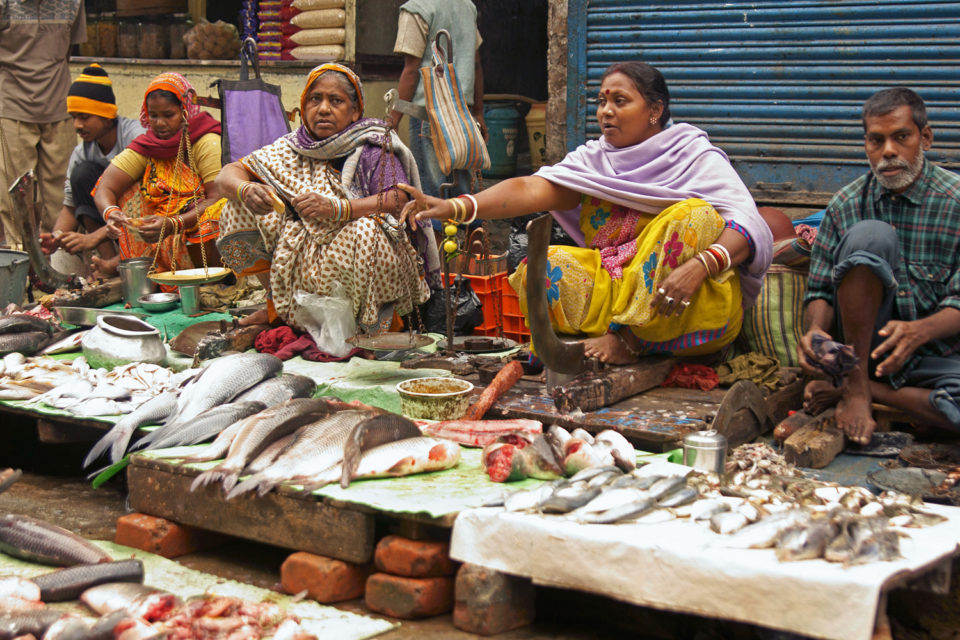Richly diverse aquatic food systems can ensure healthy and sustainable diets for all, determines study led by Dr. Shakuntala Haraksingh Thilsted, this year’s World Food Prize Laureate

Aquatic foods aren’t just an important source of high-value protein – their nutritional profile and broad diversity mean that they’re also uniquely positioned to help deliver resilient global food systems and to support critical periods of human development, the United Nations’ first discussion paper on the subject determined.
With contributions from WorldFish and the Food and Agriculture Organization of the United Nations (FAO), “The role of aquatic foods in sustainable healthy diets” highlights that while aquatic foods provide more than 3 billion people with at least 20 percent of their animal protein and are also a central component to local food production, culture and diets, their essential role is still often overlooked.
Stating that for many poor rural populations in many low- and middle-income countries, fish is often the most accessible, affordable or preferred animal-source food, it also points out that vulnerable groups such as pregnant, lactating women and young children don’t consume enough aquatic foods, and underlines that these are particularly important for nutrition, health, physical and cognitive development in the first 1,000 days of life.
While the paper further qualifies that the production and harvesting of many aquatic foods often have a much lower carbon footprint and fewer biodiversity impacts when compared to production of many livestocks, it also determines that the present discourse on food systems fails to recognize the diversity of aquatic foods and their potential to contribute to sustainable healthy diets.
Maximizing utilization

With the paper asserting that for aquatic foods to provide healthy and sustainable diets for the global population, they must be made “available, accessible, affordable and desired,” says one of its authors, and this year’s World Food Prize Laureate, Dr. Shakuntala Haraksingh Thilsted. The WorldFish Global Lead for Nutrition and Public Health told the Advocate it’s essential that all species and varieties are properly utilized.
“The diversity on the plate for nutritious, safe and affordable foods is a solution that can nourish billions. Therefore, we have to ensure the diversity is present throughout entire food systems, from production to consumption,” she said. “The long-term dangers of not fully using the diversity of aquatic foods – animals, plants, microorganisms – in the food system means we will not reach our goals of nourishing people and planet.”
Thilsted also acknowledged that some demographics have traveled much further on this journey than others.
“In high-income countries, there is a focus on a few finfish species for both production and consumption, and the diversity is getting narrower with time. On the other hand, in many low- and middle-income countries across the globe, the consumption and supply have focused on a diverse variety of aquatic foods, and this continues to be so in communities living near coasts and inland water bodies,” she said. “To exploit the diversity of species for nourishing nations, there are multiple pathways and these can be context specific, depending on the geographical location, the types of producers available, and the types of consumers.”
With aquaculture expected to increasingly contribute to the global seafood supply and consumption in the decades ahead, Thilsted said that inland and marine farming systems also need to increase the diversity of aquatic foods that they produce – to include more animals, plants and microorganisms.
It’s also important producers improve the nutritional value of their products, and also increase the resilience of their production systems, she added.
Telling the story
The UN paper maintains that encouraging people to eat low-trophic aquatic foods is “undoubtedly the prime strategy” for using the planet’s aquatic resources more efficiently and mitigating the environmental impacts of food production.
It also proposes jellyfish as a potential food source and so-far “untapped aquatic biomass.” And while this might be seen as a bold step beyond the comfort zone for many consumers, particularly those that continue to focus on a handful of core species like tuna, salmon, shrimp, pollock and cod, Thilsted offered that “food habits and food choices are continuously evolving,” giving the example that that high-energy, low-nutrient snack foods have gained prominence in the food system.
“Products can be manufactured, with the use of technology and the understanding of demand, so that they are more desirable and acceptable.”
In ensuring that people of all means and geographies can have access to healthy seafood species, there’s a wide range of technologies available – from solar drying tents to lab-based foods – that could be suitable for the different geographies and population groups, she said: “These can be employed to promote better access to nutritious, safe and affordable aquatic foods.”
The long-term dangers of not fully using the diversity of aquatic foods – animals, plants, microorganisms – in the food system means we will not reach our goals of nourishing people and planet.
With regards to innovations, Thilsted stressed that technologies for the poor and vulnerable must be made affordable, accessible and appropriate, such as solar drying tents in the Great Lakes regions of Africa, and energy sources for small-scale fishers’ boats.
She also added that better communications and the generation of greater awareness among policymakers, producers and consumers of the diversity of the species available, and the benefits that they offer with regards to such things as human health have an important role to play in this new future.
“We will also need to reach investors – to drive the investments in aquatic foods as this is comparatively lower than investments in other food groups, e.g., staple food crops,” she said.
This agenda should be driven by stakeholders from across the food systems, she said, adding that the “voices and aspirations” of those people that depend on aquatic foods for food and nutrition security and livelihoods “should be heard,” and included in the framing of the agenda, and in developing appropriate solutions.
Holistic solution
Thilsted explained that the discussion paper builds on the framework for food and nutrition security.
This, she said, was defined by the Committee on World Food Security 2012 as existing when all people at all times have physical, social and economic access to food, which is consumed in sufficient quantity and quality to meet their dietary needs and food preferences. Food and nutrition security is also supported by an environment of adequate sanitation, health services and care, allowing for a healthy and active life.
Therefore, in the lead up to the 2021 UN Food Systems Summit, taking place in Rome in July, the discussion paper is intended to guide policy development and ensure aquatic foods are an essential part of food systems transformation for healthy people and planet.
It will feed into the summit’s five action tracks, with recommended strategies such as shifting consumer behavior, ensuring the sustainability of production systems, reducing loss and waste in aquatic food supply chains, and improving the governance of aquatic resources for food and nutrition security.
Thilstead is Vice-Chair of the UN Food Systems Summit 2021 Action Track 4: Advance Equitable Livelihoods.
Follow the Advocate on Twitter @GAA_Advocate
Now that you've finished reading the article ...
… we hope you’ll consider supporting our mission to document the evolution of the global aquaculture industry and share our vast network of contributors’ expansive knowledge every week.
By becoming a Global Seafood Alliance member, you’re ensuring that all of the pre-competitive work we do through member benefits, resources and events can continue. Individual membership costs just $50 a year. GSA individual and corporate members receive complimentary access to a series of GOAL virtual events beginning in April. Join now.
Not a GSA member? Join us.
Author
-

Jason Holland
Jason Holland is a London-based writer for the international seafood, aquaculture and fisheries sectors. Jason has accrued more than 25 years’ experience as a B2B journalist, editor and communications consultant – a career that has taken him all over the world. He believes he found his true professional calling in 2004 when he started documenting the many facets of the international seafood industry, and particularly those enterprises and individuals bringing change to it.
Related Posts

Responsibility
Can nutrition-sensitive aquaculture futureproof fish farming?
Research finds that nutrition-sensitive aquaculture can benefit public health through diverse, nutrient-rich seafood, and enabling equitable access to it.

Responsibility
A wider view: At GOAL, focus steers to fisheries, food systems and the future
During the virtual event, researchers discussed the importance of aquatic foods, which billions worldwide rely on for protein and micronutrients.

Responsibility
Can sustainable mariculture match agriculture’s output?
Global, sustainable mariculture production, developed on a massive, sustainable scale and using just a small fraction of the world’s oceanic areas, could eventually match the output of land-based agriculture production. Scale and international law considerations require the involvement of many stakeholders, including national governments and international organizations.

Responsibility
Aquaculture Exchange: Peter Bridson
Peter Bridson, who steered aquaculture research for Seafood Watch and its highly influential marketplace recommendations for six years, now runs his own consultancy, Seagreen Research. He discusses global food security, certification standards and gradually changing perceptions about farmed salmon.

